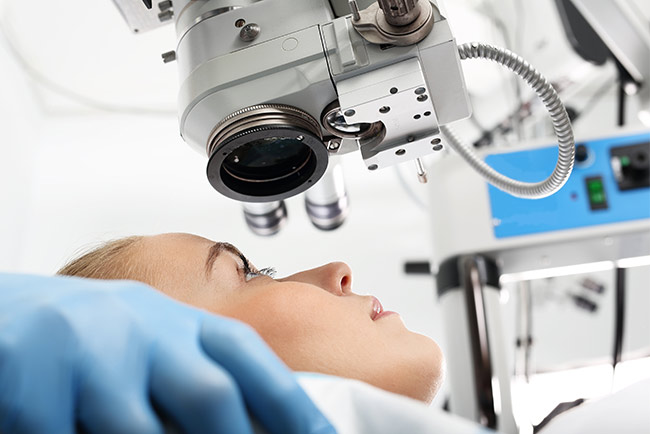
SLT Glaucoma Laser To Reduce Intraocular Pressure
The SLT laser or Selective Laser Trabeculoplasty is a treatment that is performed in the ophthalmology office, in one session, lasts a few minutes, and does not present risks. This treatment is very effective in certain cases of glaucoma, where it is possible to lower intraocular pressure by up to 30%.
What is the SLT laser?
The trabeculoplasty Selective Laser (SLT) is a laser for safe and effective treatment glaucoma. It is presented as an alternative to the treatment of glaucoma in patients with ocular hypertension or primary or secondary open-angle glaucoma , who have difficulties with the usual treatment (such as intolerance or lack of blood pressure control).
By using the SLT laser, there is a controlled and intermittent heating of the pigmented cells of the trabecular meshwork , an effect known as selective thermolysis.
It is a mechanism that allows to regulate intraocular pressure, but in a less invasive and traumatic way than glaucoma surgery such as trabeculectomy or non-perforating deep sclerectomy , which we perform in the operating room and which, although they are very safe, are not exempt of the usual risks of an operating room.
This treatment is defined as selective since it acts by selecting the pigment cells of the trabecular meshwork, in charge of regulating intraocular pressure and without causing any damage to the rest of the tissues.
What is this laser treatment for?
The SLT laser is used in those patients where the eye drops fail to reduce the pressure in the eye sufficiently , or they cause significant side effects. In cases of glaucoma , it can also be used as an initial treatment.
Studies carried out in relation to this issue indicate a decrease of between 20% and 30% in intraocular pressure in 70% of patients, with a single 360º trabecular session. In 30% of cases, a re-treatment is needed after 5 years.
How does Selective Laser Trabeculoplasty work?
It should be noted that the SLT laser activates a tissue remodeling process, without causing thermal damage. Reason why it can be repeated whenever it is needed, and does not influence other possible glaucoma treatments that the patient may need in the future.
The process of the selective laser trabeculoplasty operation is as follows:
Before
The preparation of the treatment consists of the application of a miotic eye drops that have anesthetic and anti-inflammatory effects.
During
The session lasts between 10 and 15 minutes , and the patient does not experience pain during the session . A YC-200 S PLUS laser is used that acts at a wavelength of 532 nanometers and in a space of time of 3 nanoseconds, producing the selective heating of the pigmented cells of the trabecular meshwork, without burning them.
In this way, an inflammatory reaction occurs that cleanses and stimulates these cells, making them work better and the aqueous humor can escape from the eyeball.
Postoperative
For a few weeks a mild anti-inflammatory eye drops will be applied . The patient can develop his life normally after treatment.
However, the effects of selective laser trabeculoplasty are not instantaneous, so it is necessary to maintain the treatment of ocular hypotension for up to 8 weeks .
After that time, the SLT laser treatment should have produced its maximum effects. At this point, its effectiveness can be evaluated.
The SLT laser treatment for glaucoma does not require hospitalization of the patient , who in the following days and weeks can lead a normal life once the effect of the drops wears off.
Possible risks of the SLT laser
Inflammation is common , although in most cases it is usually mild and is treated by observation, eye drops, or an oral nonsteroidal anti-inflammatory drug.
Furthermore, after the laser there is around a 5% incidence of increased intraocular pressure, which can be controlled with the same glaucoma drugs. Normally, it disappears after 24 hours.
In which patients is it recommended?
It will be the ophthalmologist who decides whether selective laser trabeculoplasty is appropriate for the patient. In principle, TLS is indicated in cases of primary or secondary open-angle glaucoma (in which the drainage system in the front of the eye is open) and in which it is necessary to reduce the intraocular pressure.
On the other hand, laser treatment is contraindicated in patients with narrow-angle glaucoma or keratopathies that make it difficult to see the angle and trabeculum correctly, as well as in those with inflammatory or traumatic glaucomas .
This laser treatment can be performed in patients previously treated with Argon Laser Trabeculoplasty, with the same efficacy as the previous treatment. However, a lower blood pressure drop is foreseeable in patients who have undergone glaucoma surgery, which is why, in these cases, TLS is not recommended.
Side effects of SLT in glaucoma
The side effects of SLT are usually minimal or mild . As we have seen, in 5% of patients there is a peak of ocular hypertension, and also a not very significant ocular inflammatory reaction .
These symptoms can be controlled with hypotensive medication and, in any case, in the days after treatment the intraocular pressure should be measured regularly.




